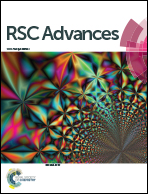Electrochemical oxidation of boron-doped nickel–iron layered double hydroxide for facile charge transfer in oxygen evolution electrocatalysts†
Abstract
The oxygen evolution reaction (OER) is the key reaction in water splitting systems, but compared with the hydrogen evolution reaction (HER), the OER exhibits slow reaction kinetics. In this work, boron doping into nickel–iron layered double hydroxide (NiFe LDH) was evaluated for the enhancement of OER electrocatalytic activity. To fabricate boron-doped NiFe LDH (B:NiFe LDH), gaseous boronization, a gas–solid reaction between boron gas and NiFe LDH, was conducted at a relatively low temperature. Subsequently, catalyst activation was performed through electrochemical oxidation for maximization of boron doping and improved OER performance. As a result, it was possible to obtain a remarkably reduced overpotential of 229 mV at 10 mA cm−2 compared to that of pristine NiFe LDH (315 mV) due to the effect of facile charge-transfer resistance by boron doping and improved active sites by electrochemical oxidation.



 Please wait while we load your content...
Please wait while we load your content...